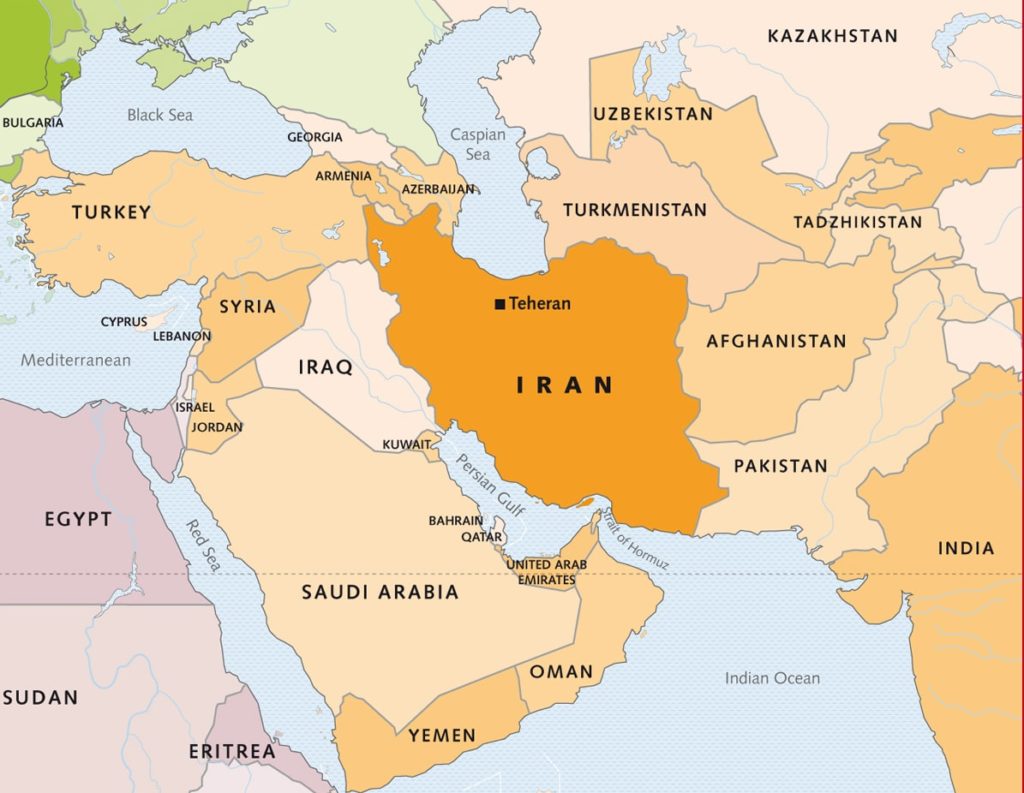February 07 2020
by Warren L. Nelson

With its attack on a base in Iraq used by the American military, the Islamic Republic says its immediate goal now is to have all American troops kicked out of the Middle East entirely.
Of course, that has been a stated goal of the regime over four decades. But Iran is now talking about it more often and speaking of it as an immediate goal.
Supreme Leader Ali Kh-menehi elevated that issue to the top of the list January 8 in a speech at Qom. “This region does not accept the presence of the United States. The people in the region and the regional governments rising from the people do not accept this,” he said, distinguishing the regional governments “rising from the people, apparently, meaning Syria, Yemen and perhaps Iraq, from all the other governments, almost all of which have invited in US troops.
Since then, he has been echoed by many other Iranian officials, such as Maj. Gen. Yahya Rahim-Safavi, Khamenehi’s top military adviser, who said, “Definitely, the United States and its allies will be expelled from the region of West Asia and they will not stay in the region.”
President Rohani has joined in this refrain, linking the assassination of Maj. Gen. Qassem Soleymani to the expulsion policy. “We believe that the US should receive its chief response [to the assassination] from the people of the region. They [Americans] cut off dear General Soleymani’s hand in this atrocity. The revenge for this is for us to sever and cut off America’s feet from the region.”
The morning after the Iranian attack on the Ain Al-Asad base in Iraq, Foreign Minister Mohammad-Javad Zarif said, “The Islamic Republic had to show a military reaction to the US government’s measure [the assassination] and it did—but this is not the end game. The end will be the withdrawal of the US, which does not need military action.”
What has changed to prompt the expulsion of the Americans to move front and center in Iran’s propaganda? The minimal attack on the Aid Al-Asad base in Iraq certainly isn’t going to prompt the Americans to cut and run. But it might have made Iran think that other countries will now be prepared to kick the Americans out to avoid Iranian antipathy.
Of course, the Americans have troops in every country west of Iran precisely because most of those countries are fearful of the Islamic Republic.
There are some changes. When the United States did not retaliate after Iran fired missiles at Saudi oil installations in September, many Arabs began to say that American promises of defense meant nothing under President Trump. There are signs the assassination of Maj. Gen. Qassem Soleymani may have made the Arabs feel more trustworthy of the Americans.
The Iraqi parliament, however, has voted to require the Americans to leave. But it set no deadline and the Iraqi prime minister hasn’t signed the legislation. Many Iraqi politicians have told the Americans the legislation was passed just to appease hardliners and they really do not want the Americans to leave. Sunnis and Kurds are also almost unanimously opposed to the idea and see it as an Iranian ploy to get a stranglehold on Iraq.
Iraqi political cleric Moqtada as-Sadr ordered up a “million-man march” for January 24 to demand the Americans leave. The million-man march fell about 80 percent short of his call. The rally didn’t last long and observers noted anti-Iranian chants were mixed in with the anti-American chants
It also should be noted that the US troops in Iraq and Afghanistan are not focused on Iran but on the problems of the Taliban and Islamic State.
The biggest threat to Iran is posed by the hundreds of US aircraft based at Al-Udeid airbase in Qatar. Qatar is friendly with Iran and has even become somewhat dependent on it since its Arab neighbors got mad at it and cut off trade. Qatar must get most of its imports now through Iran. So, is Qatar open to kicking out the Americans? No way.
Ground troops available to invade Iran are based in Kuwait. The numbers vary widely as the US sends battalions to Kuwait only a temporary basis to practice desert warfare of the kind that would be used if Iran were ever invaded. The more troops that go to Kuwait, the more that are trained to invade.
Oddly, Iran doesn’t talk much about the US forces in Kuwait and Qatar. It talks mainly about troops in Afghanistan and Iraq, who pose no threat to Iran, and the US Navy in the Persian Gulf, which uses Bahrain as a base but would still send ships from the US even if Bahrain kicked the Navy out. In fact, the aircraft carriers that are rotated to the region by the US Navy come from bases in the US and only use Bahrain to give sailors some time off.
Saudi Arabia kicked all the American troops out a decade ago when their large presence became a domestic issue. But thousands came back last October after those Iranian missiles hit the Saudi oil installations. So, that attack actually pushed the Saudis closer to Washington, not further away.
To complete the tour around the neighborhood, the US also has troops in Oman, the UAE and Turkey. In other words, there are US troops in every country to the west of Iran with which Iran has a land or sea border.
But most of those forces provide no offensive threat to Iran. For example, the troops in Saudi Arabia only man air defense units. There are no ground invasion forces.
The offensive threat in the region comes from Army ground troops in Kuwait, US Air Force planes in Qatar, US Navy aircraft on an aircraft carrier in the region, Marines on board ships that are trained and equipped to land over a beach and invade countries, the many ships and submarines in the region that carry hundreds of Tomahawk missiles, and US bombers that can be dispatched to Iran from bases in the United States.
But the Islamic Republic continues to make the removal of US troops from the region its top general priority—at least rhetorically—although it focuses on Iraq and Syria, where the US presence is small (about 6,000 troops all in all) and where the US troops are operating almost entirely against the Islamic State in an effective alliance with, not against, Iran.
In other words, the great campaign to expel the Americans appears more rhetorical than real—an effort to espouse a policy in lieu of any further engagement with the United States. The policy of striving for US expulsion is likely just a cover-up for avoiding a military tangle with the Americans.
It needs also to be remembered that President Trump has declared that he wants to pull all US troops from the region and get the United States out the Middle East—so Iran’s verbal attacks on the US presence do not even conflict with Trump’s policy.
In response to calls to leave Iraq, Trump said last week, “At some point, we want to get out, but this isn’t the right point.”























